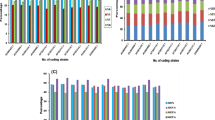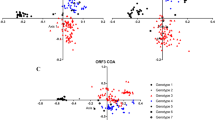Abstract
Recent outbreaks of Zika virus (ZIKV) in Africa, Latin America, Europe, and Southeast Asia have resulted in serious health concerns. To understand more about evolution and transmission of ZIKV, detailed codon usage analysis was performed for all available strains. A high effective number of codons (ENC) value indicated the presence of low codon usage bias in ZIKV. The effect of mutational pressure on codon usage bias was confirmed by significant correlations between nucleotide compositions at third codon positions and ENCs. Correlation analysis between Gravy values, Aroma values and nucleotide compositions at third codon positions also indicated some influence of natural selection. However, the low codon adaptation index (CAI) value of ZIKV with reference to human and mosquito indicated poor adaptation of ZIKV codon usage towards its hosts, signifying that natural selection has a weaker influence than mutational pressure. Additionally, relative dinucleotide frequencies, geographical distribution, and evolutionary processes also influenced the codon usage pattern to some extent.





Similar content being viewed by others
References
Ahn I, Son HS (2012) Evolutionary analysis of human-origin influenza A virus (H3N2) genes associated with the codon usage patterns since 1993. Virus Genes 44:198–206
Belalov IS, Lukashev AN (2013) Causes and implications of codon usage bias in RNA viruses. PLoS One 8:e56642
Besnard M, Lastere S, Teissier A, Cao-Lormeau V, Musso D (2014) Evidence of perinatal transmission of Zika virus, French Polynesia, December 2013 and February 2014. Euro Surveill 19
Butt AM, Nasrullah I, Tong Y (2014) Genome-wide analysis of codon usage and influencing factors in chikungunya viruses. PLoS One 9:e90905
Butt AM, Nasrullah I, Qamar R, Tong Y (2016) Evolution of codon usage in Zika virus genomes is host and vector specific. Emerg Microbes Infect 5:e107
Chen Y, Shi Y, Deng H, Gu T, Xu J, Ou J, Jiang Z, Jiao Y, Zou T, Wang C (2014) Characterization of the porcine epidemic diarrhea virus codon usage bias. Infect Genet Evol 28:95–100
Cristina J, Moreno P, Moratorio G, Musto H (2015) Genome-wide analysis of codon usage bias in Ebolavirus. Virus Res 196:87–93
Cristina J, Fajardo A, Sonora M, Moratorio G, Musto H (2016) A detailed comparative analysis of codon usage bias in Zika virus. Virus Res 223:147–152
Dorn A, Kippenberger S (2008) Clinical application of CpG-, non-CpG-, and antisense oligodeoxynucleotides as immunomodulators. Curr Opin Mol Ther 10:10–20
Faye O, Diallo D, Diallo M, Weidmann M, Sall AA (2013) Quantitative real-time PCR detection of Zika virus and evaluation with field-caught mosquitoes. Virol J 10:311
Gao D, Lou Y, He D, Porco TC, Kuang Y, Chowell G, Ruan S (2016) Prevention and control of Zika as a mosquito-borne and sexually transmitted disease: a mathematical modeling analysis. Sci Rep 6:28070
Greenacre MJ (1984) Theory and applications of correspondence analysis. Academic Press, London
Haddow AD, Schuh AJ, Yasuda CY, Kasper MR, Heang V, Huy R, Guzman H, Tesh RB, Weaver SC (2012) Genetic characterization of Zika virus strains: geographic expansion of the Asian lineage. PLoS Negl Trop Dis 6:e1477
Hu JS, Wang QQ, Zhang J, Chen HT, Xu ZW, Zhu L, Ding YZ, Ma LN, Xu K, Gu YX, Liu YS (2011) The characteristic of codon usage pattern and its evolution of hepatitis C virus. Infect Genet Evol 11:2098–2102
Jenkins GM, Holmes EC (2003) The extent of codon usage bias in human RNA viruses and its evolutionary origin. Virus Res 92:1–7
Lara-Ramírez EE, Salazar MI, MeJ López-López, Salas-Benito JS, Sánchez-Varela A, Guo X (2014) Large-scale genomic analysis of codon usage in dengue virus and evaluation of its phylogenetic dependence. Biomed Res Int 2014:851425
Levin DB, Whittome B (2000) Codon usage in nucleopolyhedroviruses. J Gen Virol 81:2313–2325
Lobry JR, Gautier C (1994) Hydrophobicity, expressivity and aromaticity are the major trends of amino-acid usage in 999 Escherichia coli chromosome-encoded genes. Nucleic Acids Res 22:3174–3180
Lucey DR (2016) Time for global action on Zika virus epidemic. BMJ 352:i781
Marano G, Pupella S, Vaglio S, Liumbruno GM, Grazzini G (2015) Zika virus and the never-ending story of emerging pathogens and transfusion medicine. Blood Transfus 5:1–6
Marín A, Bertranpetit J, Oliver JL, Medina JR (1989) Variation in G + C-content and codon choice: differences among synonymous codon groups in vertebrate genes. Nucleic Acids Res 17:6181–6189
Musso D, Roche C, Robin E, Nhan T, Teissier A, Cao-Lormeau VM (2015) Potential sexual transmission of Zika virus. Emerg Infect Dis 21:359–361
Peden J (1999) Analysis of codon usage. Department of Genetics, University of Nottingham, Nottingham
Petersen E, Wilson ME, Touch S, McCloskey B, Mwaba P, Bates M, Dar O, Mattes F, Kidd M, Ippolito G, Azhar EI, Zumla A (2016) Rapid spread of Zika virus in the americas—implications for public health preparedness for mass gatherings at the 2016 Brazil Olympic Games. Int J Infect Dis 44:11–15
Puigbò P, Bravo IG, Garcia-Vallve S (2008) CAIcal: a combined set of tools to assess codon usage adaptation. Biol Direct 3:38
Puigbò P, Bravo IG, Garcia-Vallvé S (2008) E-CAI: a novel server to estimate an expected value of Codon Adaptation Index (eCAI). BMC Bioinform 9:65
Rubin EJ, Greene MF, Baden LR (2016) Zika Virus and Microcephaly. N Engl J Med 374:984–985
Sharp PM, Li WH (1986) An evolutionary perspective on synonymous codon usage in unicellular organisms. J Mol Evol 24:28–38
Singh NK, Tyagi A, Kaur R, Verma R, Gupta PK (2016) Characterization of codon usage pattern and influencing factors in Japanese encephalitis virus. Virus Res 221:58–65
Tulloch F, Atkinson NJ, Evans DJ, Ryan MD, Simmonds P (2014) RNA virus attenuation by codon pair deoptimisation is an artefact of increases in CpG/UpA dinucleotide frequencies. Elife 3:e04531
van Hemert F, Berkhout B (2016) Nucleotide composition of the Zika virus RNA genome and its codon usage. Virol J 13:95
WHO (2016) Zika virus microcephaly and Guillain–Barré syndrome situation report. World Health Organization
Wreschner DH, McCauley JW, Skehel JJ, Kerr IM (1981) Interferon action–sequence specificity of the ppp(A2’p)nA-dependent ribonuclease. Nature 289:414–417
Wright F (1990) The ‘effective number of codons’ used in a gene. Gene 87:23–29
Xu Y, Jia R, Zhang Z, Lu Y, Wang M, Zhu D, Chen S, Liu M, Yin Z, Cheng A (2015) Analysis of synonymous codon usage pattern in duck circovirus. Gene 557:138–145
Zhang J, Wang M, Liu WQ, Zhou JH, Chen HT, Ma LN, Ding YZ, Gu YX, Liu YS (2011) Analysis of codon usage and nucleotide composition bias in polioviruses. Virol J 8:146
Zhang S, Li D (2016) Zika virus and Zika viral disease. Chin J Virol 32:121–127
Qin H, Wu WB, Comeron JM, Kreitman M, Li WH (2004) Intragenic spatial patterns of codon usage bias in prokaryotic and eukaryotic genomes. Genetics 168:2245–2260
Freire CCM, Iamarino A, Neto DFL, Sall AA, Zanotto PMA (2015) Spread of the pandemic Zika virus lineage is associated with NS1 codon usage adaptation in humans. bioRxiv. doi:10.1101/032839
Acknowledgements
We are thankful to Director, School of Animal Biotechnology, Guru Angad Dev Veterinary and Animal Sciences University, Ludhiana for the support.
Author information
Authors and Affiliations
Corresponding author
Ethics declarations
Funding information
There was no role of any funding agencies in the current study.
Electronic supplementary material
Below is the link to the electronic supplementary material.
Rights and permissions
About this article
Cite this article
Singh, N.K., Tyagi, A. A detailed analysis of codon usage patterns and influencing factors in Zika virus. Arch Virol 162, 1963–1973 (2017). https://doi.org/10.1007/s00705-017-3324-2
Received:
Accepted:
Published:
Issue Date:
DOI: https://doi.org/10.1007/s00705-017-3324-2




